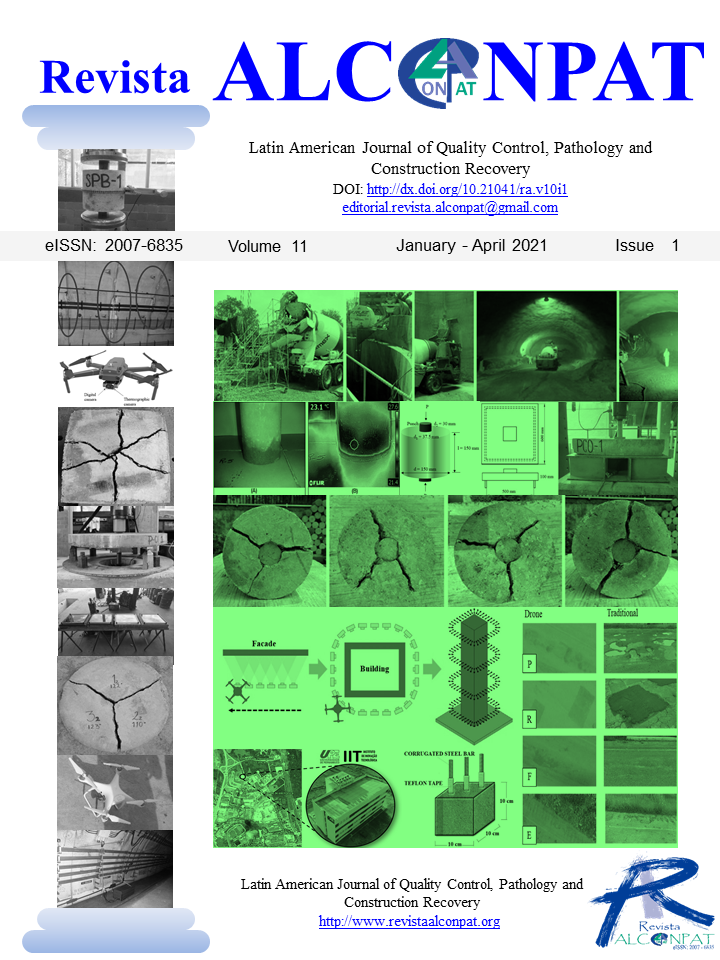Comparative analysis of the effectiveness and efficiency of three waterproofing systems
DOI:
https://doi.org/10.21041/ra.v11i1.509Keywords:
waterproofing systems, effectiveness, efficiency, accelerated aging, yield reductionAbstract
The objective of this study was to comparatively analyze waterproofing systems used in Brazil. The evaluated products were: asphalt emulsion, acrylic resin and thermoplastic resin. In order to evaluate the effectiveness of the systems the tests measured the tightness and the absorption by immersion and capillarity, the last one was also analyzed by thermographic images. For the systems efficiency analysis an accelerated aging pattern was adopted, which consisted of alternating the samples in wet and dry cycles. The results indicate a good performance for the studied systems, in comparison to the non-impermeable series, it presented lower absorbance (approximately 300%). The accelerated aging test indicated, after 140 days of age, a reduction in the performance of the waterproofed serie.
Downloads
References
Aldea, C., Shah, S. P., Karr, A. (1999) “Permeability of cracked concrete” Materials and Structures, 32, pp. 370–376. https://doi.org/10.1007/BF02479629
Andrello, J. M., Takagi, E. (2017) “Debate técnico: impermeabilização in loco” Construção Mercado - Téchne, PINI.
Associação Brasileira de normas Técnicas. (2005). NBR 9685: Emulsão Asfáltica para Impermeabilização. Rio de Janeiro.
Associação Brasileira de normas Técnicas. (2005). NBR 9778: Argamassa e concreto endurecidos - Determinação da absorção de água, índice de vazios e massa específica. Rio de Janeiro.
Associação Brasileira de normas Técnicas. (2008). NBR 13321: Membrana acrílica para impermeabilização. Rio de Janeiro.
Associação Brasileira de normas Técnicas. (2010). NBR 15885: Membrana de Polímero Acrílico com ou sem Cimento para Impermeabilização. Rio de Janeiro.
Associação Brasileira de normas Técnicas. (2012). NBR 9779: Argamassa e concreto endurecidos – Determinação da absorção de água por capilaridade. Rio de Janeiro.
Associação Brasileira de normas Técnicas. (2013). NBR 15575: Edificações habitacionais - Desempenho. Rio de Janeiro.
Basheer, I., Kropp, J., Cleland, D. J. (2001) “Assessment of the durability of concrete from its permeation properties: a review” Construction and Building Materials, 15 (2-3), pp. 93– 103. https://doi.org/10.1016/S0950-0618(00)00058-1
Bauer, E., Vasconcelos, P. H. C., Granato, J. E. (2010) “Sistemas de impermeabilização e isolamento térmico” In: ISAIA, G. C. Materiais de construção civil e princípios de ciência e engenharia dos materiais. São Paulo: Ed. IBRACON.
Cortizo, E. C. (2007) “Avaliação da técnica de termografia infravermelha para identificação de estruturas ocultas e diagnóstico de anomalias em edificações: Ênfase em edificações de Patrimônio Histórico” 178f. Tese (Doutorado) - Universidade Federal de Minas Gerais, Escola de Engenharia, Departamento de Engenharia Mecânica. Belo Horizonte.
Freitas, J. G., Carasek, H., Cascudo, O. (2014) “Utilização de termografia infravermelha para avaliação de fissuras em fachadas com revestimento de argamassa e pintura”. Ambiente Construído, Porto Alegre, v. 14, n. 1, p. 57-73. http://dx.doi.org/10.1590/S1678-86212014000100006
Gao, J., Yu, Z., Song, L., Wang, T., Wei, S. (2013) “Durability of concrete exposed to sulfate attack under flexural loading and drying–wetting cycles” Construction and Building Materials. v. 39, pp. 33-38. https://doi.org/10.1016/j.conbuildmat.2012.05.033
Gong, J., Cao, J., Wang, Y. (2016) “Effects of sulfate attack and dry-wet circulation on creep of fly-ash slag concrete” Construction and Building Materials. v.125, pp.12-20. https://doi.org/10.1016/j.conbuildmat.2016.08.023
Jiang, L., Niu, D. (2016) “Study of deterioration of concrete exposed to different types of sulfate solutions under drying-wetting cycles” Construction and Building Materials. v. 117, pp. 88-98. https://doi.org/10.1016/j.conbuildmat.2016.04.094
Lourenço, T., Matias, L., Faria, P. (2017) “Anomalies Detection in Adhesive Wall Tiling Systems by Infrared Thermography.” Construction and Building Materials, v. 148, p. 419-428. https://doi.org/10.1016/j.conbuildmat.2017.05.052
Maldague, X. (2001) “Infrared and Thermal Testing: nondestructive testing handbook.” 3. ed. Columbus, OH: Patrick O. Moore.
Melrinho, A., Matias, L., Faria, P. (2015). Detecção de anomalias em impermeabilizações de coberturas em terraço através da termografia de infravermelhos. Tech ITT by Construlink, 13(37), 29-38.https://run.unl.pt/bitstream/10362/16576/1/RI%20-%20Melrinho%20et%20al_RIT%2037_2015.pdf
Menezes, M. (2018) “Influência da umidade do substrato na aderência de sistema de impermeabilização com manta asfáltica aderida à maçarico” IBI - Instituto Brasileiro de Impermeabilização, 16 p, São Paulo.
Morgado, J. M., et al. (2018) “Guia de aplicação da norma de desempenho para impermeabilização. Especificação, aplicação e contratação com foco no atendimento à ABNT 15575/2013” IBI – Instituto Brasileiro de Impermeabilização, Rio de Janeiro.
Ngala, V. T., Page, C. L. (1997) “Effects of carbonation on pore structure and diffusional properties of hydrated cement pastes”. Cement and Concrete Research, V. 27, n.7, pp. 995-1007. https://doi.org/10.1016/S0008-8846(97)00102-6
Pezzolo, V. (2013) “Conheça os tipos de impermeabilizante” Equipe Obra Prima, PINI.
Picchi, F. A. (1986) “Impermeabilização de coberturas” Editora Pini, São Paulo.
Rocha, J. H. A., Santos, C. F. dos, Oliveira, J. B. de, Albuquerque, L. K dos S., Póvoas, Y. V. (2018) “Detecção de infiltração em áreas inerenas de edificações com termografia infravermelha: estudo de caso” Ambiente Construído, Porto Alegre, V. 18, n.4, pp. 329-340. https://doi.org/10.1590/s1678-86212018000400308
Rossignolo, J. A. (2005) “Avaliação da porosidade e do teor de CH de pastas de cimento Portland com Sílica Ativa e Látex SRB” Revista Matéria, V.10, n.3, pp. 437-442. http://www.materia.coppe.ufrj.br/sarra/artigos/artigo10654
Silveira, M. A., Granato, J. E. (2013) “Diretrizes de desempenho para produtos de impermeabilização”. 13º Simpósio Brasileiro de Impermeabilização.
Downloads
Published
How to Cite
Issue
Section
License
_______________________________
License in effect from September 2020
You are free to:
- Share — copy and redistribute the material in any medium or format for any purpose, even commercially.
- Adapt — remix, transform, and build upon the material for any purpose, even commercially.
- The licensor cannot revoke these freedoms as long as you follow the license terms.
Under the following terms:
- Attribution — You must give appropriate credit , provide a link to the license, and indicate if changes were made . You may do so in any reasonable manner, but not in any way that suggests the licensor endorses you or your use.
- No additional restrictions — You may not apply legal terms or technological measures that legally restrict others from doing anything the license permits.
Notices:
You do not have to comply with the license for elements of the material in the public domain or where your use is permitted by an applicable exception or limitation .
No warranties are given. The license may not give you all of the permissions necessary for your intended use. For example, other rights such as publicity, privacy, or moral rights may limit how you use the material.





















.png)














